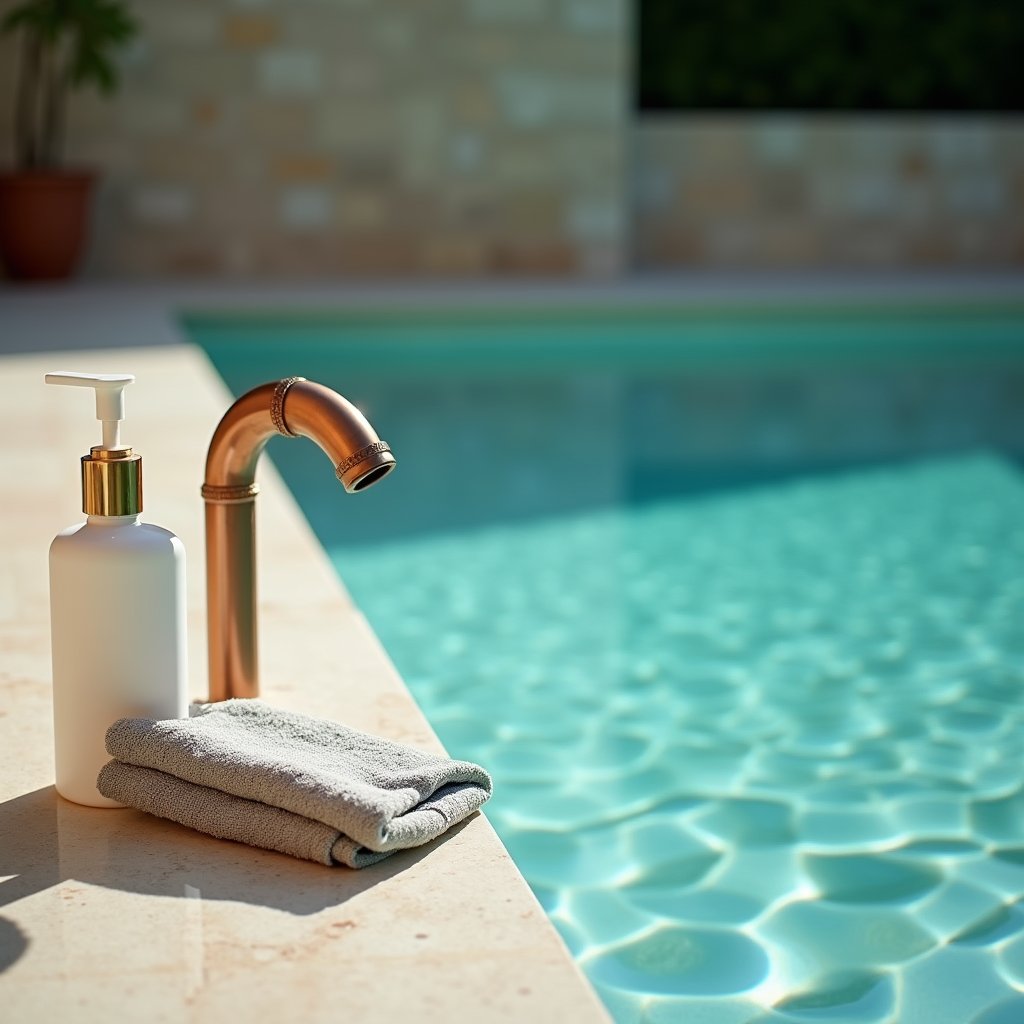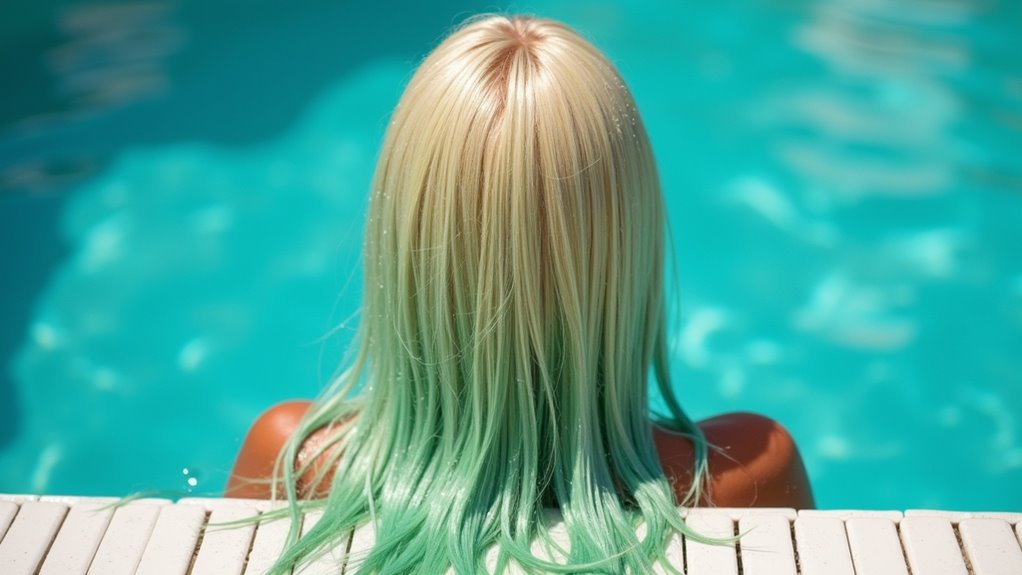Your blonde hair turns green in pools due to oxidized copper ions, not chlorine as commonly believed. When you swim, these copper ions (from algaecides or corroded pipes) bind chemically to the protein molecules in your hair’s cuticle layer. Lighter hair colors show this effect more prominently due to their reduced pigmentation. Pre-swim conditioning and specialized treatments can prevent this metallic discoloration, with several scientific approaches offering effective solutions to this chemical reaction.
Key Takeaways
- Copper in pool water, not chlorine, is the primary cause of green hair when it oxidizes and binds to hair proteins.
- Blonde hair shows green tints more prominently because its lighter color makes copper discoloration more visible than in darker hair.
- Copper enters pools through algaecides, corroded copper pipes, or well water sources containing dissolved copper minerals.
- Chlorine facilitates the process by oxidizing copper into copper hydroxide, which then attaches to the hair’s cuticle layer.
- Hair’s natural porosity and protein structure make it susceptible to absorbing oxidized copper during swimming pool exposure.
The Real Science Behind Green Pool Hair

Despite popular belief that chlorine alone causes hair to turn green after swimming, the culprit is actually oxidized copper. When you’re swimming in a pool, the chlorine interaction with copper creates copper hydroxide, which then binds to the protein molecules in your hair strands.
The process becomes more pronounced due to hair porosity, as your hair’s ability to absorb and retain moisture affects how readily it takes up these copper deposits. The chemical reaction occurs when copper ions, often present in pool water from copper-based algaecides or corroded metal pipes, undergo oxidation. The resulting copper hydroxide molecules attach themselves to your hair’s cuticle layer, creating that distinctive greenish tint. This reaction is particularly visible in lighter hair colors, especially blonde, due to their lack of masking pigments.
Understanding Copper’s Role in Hair Discoloration

While copper’s presence in pool water might seem incidental, it plays a fundamental role in the chemical process of hair discoloration. When you’re exposed to pool water, copper ions bind to the protein molecules in your hair’s cuticle layer, initiating an oxidation reaction that produces the characteristic green tint.
| Copper Source | Impact Level | Effect on Hair |
|---|---|---|
| Algaecides | High | Rapid binding |
| Copper pipes | Medium | Gradual buildup |
| Well water | Variable | Inconsistent exposure |
| Metal fixtures | Low | Minimal contact |
Understanding hair chemistry is essential: your hair’s porosity and protein structure directly affect its susceptibility to copper absorption. The more porous your hair becomes from chemical treatments or sun exposure, the more readily it’ll absorb copper ions, accelerating the greening process. You’ll notice this effect particularly in lighter-colored or chemically treated hair.
Common Myths About Pool Hair

How many misconceptions about pool-related hair damage have you encountered? Let’s debunk some prevalent hair color myths and chlorine misconceptions that have persisted for years.
- You’ll often hear that chlorine directly causes hair to turn green, but it’s actually the oxidized copper compounds that create this discoloration, not the sanitizing chemical itself.
- Contrary to popular belief, your hair doesn’t absorb chlorine permanently. What you’re experiencing is a chemical reaction on the hair’s surface that’s reversible with proper cleansing techniques.
- Many assume that wetting your hair before swimming won’t help protect it, but pre-soaking with tap water actually creates a barrier that reduces the absorption of pool chemicals.
These scientific facts help dispel common misunderstandings about how pool water affects your hair’s structure and appearance.
How Metal Ions Affect Hair Structure
Metal ions found in pool water interact with your hair’s protein structure through a process called chelation, where copper (Cu2+), iron (Fe2+), and other metallic elements bind to the keratin proteins in your hair shaft. This metal ion chemistry creates coordinate covalent bonds with specific amino acid groups in your hair’s cortex, particularly the sulfur-containing cysteine residues.
When these ions attach to your hair structure, they’ll cause several changes: the metal complexes can weaken disulfide bonds, alter the hair’s natural pH, and create microscopic spaces between cuticle scales. You’ll notice these effects as your hair becomes more porous, brittle, and susceptible to further damage. The oxidation of copper ions specifically leads to the formation of copper-protein complexes, which contribute to the characteristic green tint in light-colored hair.
Prevention Methods for Swimmers
Before exposing your hair to chlorinated pool water, you can implement several scientifically-proven protective measures to minimize metal ion absorption and structural damage. Pre-swim conditioners create a protective barrier between your hair’s cuticle layer and harmful pool chemicals, while specialized swimmer’s caps reduce direct contact with treated water.
- Apply a water-resistant protective spray containing dimethicone or other hydrophobic polymers to create an impermeable shield around hair strands
- Implement a thorough pre and post-swim rinse routine using chelating shampoo to remove copper deposits before they oxidize
- Maintain ideal hair hydration through weekly deep-conditioning hair masks containing proteins and moisturizing agents
These preventive strategies help neutralize the oxidative effects of pool chemicals while preserving your hair’s natural pH balance and structural integrity.
Natural Remedies to Remove Green Tints
Despite implementing preventive measures, swimmers may still notice unwanted green discoloration in their blonde hair due to copper ion oxidation. You can neutralize these effects using natural ingredients and DIY treatments that are scientifically proven to break down copper deposits.
Mix one part tomato juice with three parts water, then saturate your hair for 15 minutes. The ascorbic acid in tomatoes chemically bonds with copper ions, facilitating their removal. Alternatively, create a paste using baking soda and water, applying it to affected areas for 10 minutes. The alkaline properties of sodium bicarbonate help dissolve metallic buildup. You can also combine apple cider vinegar with water in equal parts; the acetic acid content effectively chelates copper molecules. These natural remedies work by disrupting the copper-protein complexes that cause green tinting.
Chemical Treatments and Professional Solutions
When chemical treatments become necessary for severe copper-induced discoloration, professional chelating shampoos and commercial clarifying solutions offer targeted interventions. You’ll find that chemical treatments specifically formulated for chlorine damage can effectively neutralize and remove metallic deposits from your hair shaft.
- EDTA-based chelating treatments bind to copper ions, facilitating their removal while maintaining hair’s structural integrity
- Vitamin C-enhanced chemical solutions work through oxidation reduction, converting copper compounds into water-soluble forms
- Professional-grade clarifying treatments containing citric acid and specialized surfactants break down mineral buildup
If you’re dealing with persistent green tints, salon professionals can apply customized chemical solutions that match your hair’s porosity and damage level. These treatments often incorporate protective agents to prevent further oxidative stress while removing unwanted copper deposits.
Impact of Pool Maintenance on Hair Color
The chemical balance and maintenance protocols of swimming pools directly influence the extent of oxidative damage to blonde hair. You’ll find that proper pool chemistry management greatly affects how your hair responds to repeated exposure.
| Maintenance Factor | Impact on Hair |
|---|---|
| pH Level | Higher pH (>7.8) accelerates copper oxidation |
| Chlorine Balance | Excess chlorine strips hair’s protective oils |
| Copper Content | Raised levels increase green tinting risk |
| Alkalinity | Improper levels damage hair cuticles |
| Water Hardness | High calcium content weakens hair structure |
When pools aren’t properly maintained, you’re exposing your hair to harsh chemical environments that accelerate color distortion. Regular testing and adjustment of pool chemistry parameters help minimize adverse effects on your hair. Professional hair care treatments provide further protection against chemical damage, but they can’t completely neutralize the effects of poorly maintained pools.
Best Hair Care Products for Regular Swimmers
Regular swimmers can protect their blonde hair from chlorine damage and color distortion through specialized aquatic hair care products. You’ll need to incorporate targeted solutions that neutralize chemical residue and maintain your hair’s natural pH balance.
Specialized aquatic hair care products offer essential protection for blonde swimmers, neutralizing chlorine damage while maintaining healthy pH levels.
- Apply a swimmer’s shampoo containing chelating agents that bind to copper and chlorine molecules, preventing them from penetrating the hair shaft and causing discoloration
- Use a color protecting conditioner with UV filters and antioxidants to shield hair from both chemical and environmental damage while maintaining moisture levels
- Implement a pre-swim hair treatment containing natural oils or specialized swimming caps that create a protective barrier between your hair and pool chemicals
These scientifically formulated products work synergistically to maintain your hair’s structural integrity and prevent the oxidation processes that lead to unwanted color changes.
Long-term Effects of Pool Water on Hair Health
Prolonged exposure to swimming pool chemicals can fundamentally alter your hair’s biochemical composition, leading to progressive deterioration of its structural proteins and lipid content.
Regular chlorine exposure disrupts your hair’s natural protective barrier, causing the cuticle layer to become porous and compromised. This structural damage results in significant moisture loss, making your hair increasingly brittle and susceptible to breakage. You’ll notice your strands becoming progressively drier, rougher, and more difficult to manage.
The cumulative effects of pool chemicals can lead to permanent alterations in your hair’s elasticity and tensile strength. Your hair’s ability to retain moisture diminishes over time, potentially resulting in chronic dryness and increased susceptibility to environmental damage. These changes can persist even after you’ve stopped regular swimming, necessitating intensive rehabilitation treatments to restore your hair’s natural integrity.
Frequently Asked Questions
Does Green Hair From Swimming Pools Affect Dark-Colored Hair Too?
While copper-based pool chemicals can affect all hair types, you’ll notice minimal dark hair effects due to your hair’s natural pigmentation. The oxidation and chemical reactions occur regardless of hair color, but darker pigments mask the greenish tint that’s more visible in lighter strands. Your dark hair’s melanin fundamentally camouflages these hair color reactions, though you might observe slight green undertones in very bright lighting or if your hair’s previously been lightened.
Can Pool Water Turn Other Items Besides Hair Green?
Yes, pool water can discolor different materials through oxidation reactions. You’ll notice that pool equipment, particularly metal components like ladders and handrails, can develop greenish-blue deposits from copper oxidation. Moreover, your swimwear fabrics may experience color degradation or develop a greenish tint due to chemical interactions with chlorine and metal ions. These reactions occur when copper compounds in the water bond with protein molecules in materials.
How Quickly Can Hair Turn Green After Swimming?
Your hair can begin showing green tints after just one extended chlorine exposure session, typically within 2-4 hours of swimming. However, the discoloration’s onset varies based on multiple factors: your hair’s porosity, previous chemical treatments, and the pool’s copper concentration. With regular hair care practices, you’ll notice more pronounced green tones developing after 3-5 swimming sessions, particularly if you don’t use protective products or immediately rinse after swimming.
Is Green Hair From Pools More Common in Outdoor or Indoor Pools?
You’ll typically encounter more hair discoloration in outdoor pools compared to indoor pools due to several key factors. Outdoor pools experience higher oxidation rates from UV exposure and require increased copper-based algaecides to combat improved algae growth. Furthermore, outdoor pools’ chemical balances fluctuate more frequently due to environmental variables like rain, debris, and temperature changes, leading to greater copper ion concentrations that can bind to your hair proteins.
Can Pool Water Permanently Stain White or Gray Hair Green?
No, pool water won’t permanently stain your white or gray hair green. The oxidized copper deposits that cause the green tint can be removed through proper hair care techniques. For effective color maintenance, you’ll want to use a chelating shampoo or clarifying treatment specifically designed to remove mineral buildup. If you’re concerned about your hair’s appearance, you can also apply a pre-swim protective hair treatment that prevents copper absorption.



